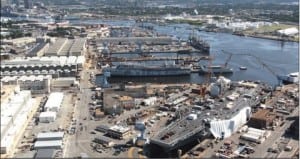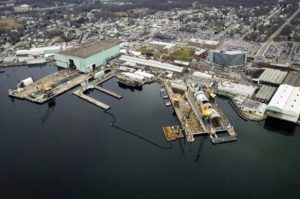This week a Navy official told a House panel the service is examining if they can speed up the effort to recapitalize the public shipyard infrastructure faster than the currently planned 20-year timeline.
In 2018, the Navy announced the Shipyard Infrastructure Optimization Plan (SIOP) to help mitigate deficiencies and overall improve infrastructure at the four public shipyards that conduct maintenance and repair work on nuclear-powered vessels. It includes investments expected to cost $21 billion over 20 years to improve dry docks, production ships and pieces, capital equipment, and increase overall efficiencies (Defense Daily, April 18, 2018).

The four shipyards are Norfolk Naval Shipyard in Portsmouth, Va.; Portsmouth Naval Shipyard in Kittery, Maine; Puget Sound Naval Shipyard and Intermediate Maintenance Facility in Bremerton, Wash.; and Pearl Harbor Naval Shipyard and Intermediate Maintenance Facility at Pearl Harbor, Hawaii.
During a House Armed Services Subcommittee on Readiness hearing on March 19, full committee Vice Chair Rep. Elaine Luria (D-Va.) pressed Commander of Naval Sea Systems Command Vice Adm. William Galinis if he needs additional resources or authorities to help speed along the SIOP.
While Galinis said he does not need additional authorities, he did not rule out asking for more resources “because we are working through that right now. And there’s a potential we may need additional resources.”
“One of the things that I’ve asked the team to look at is – we kind of notionally rolled out I’ll say a 20-year plan. I asked them to go back and look at what it would take to do this capitalization in 10 years, in 15 years. And so we’re working through that right now,” Galinis said.
He also used three examples of what the Navy is working on to improve planning maintenance, partially to be able to better integrate the SIO effort with maintain ship repair work.
Galinis said these are the amount of unplanned work that gets pushed into the availabilities after the availability starts, shop efficiencies like pushing work and locations closer to the waterfront, and availability management by doing things like using Boston Consulting Group to help incorporate best practices on processes.
The Boston Consulting Group project is part of the Naval Sustainment System-Shipyards (NSS-S) effort, modeled on a similar NSS-Aviation effort meant to recapitalize the Navy’s aircraft maintenance work.
Rep. Joe Courtney (D-Va.), chairman of the HASC Seapower subcommittee, pressed on the SIOP as well, noting the utility of moving some submarine maintenance to private industry shipyards.
“A number of years ago we had the Congressional Budget Office (CBO) take a look at the question of whether private yards, which sometimes get utilized for overflow work, cost that much more in terms of per unit costs vs. public yards. And CBO came back with a pretty strong report that in fact there is no disparity in terms of cost, in terms of using private yards.”
In 2019, the CBO released a report that found submarine maintenance tended to be 31 percent less expensive at private shipyards compared to public shipyards, but the gap has started narrowing. The report particularly focused on Docking Selected Restricted Availability (DSRA) overhauls for Los Angeles-class attack submarines from 1993 to 2017 (Defense Daily, April 22, 2019).
Private yards that can maintain nuclear-powered Navy ships and submarines include shipbuilders Huntington Ingalls Industries’ [HII] Newport News Shipbuilding in Newport News, Va., and General Dynamics’ [GD] Electric Boat in Groton, Conn.
In response to Courtney, Galinis said one element of the overall shipyard sustainment effort is development of a “15-year public sector maintenance plan.”
“This is all the work that we’re doing inside the public shipyards and we’re getting close to finishing that up here within the next month or so.”

He also noted that given the increase in planned Navy force structure in the following decades, particularly increasing submarine production, “I believe given what we see as an increase in force structure, especially in the submarine force into the ‘20s and into the early ‘30s, we are going to need capacity in the private sector to do submarine repair work. And that’s just kind of an initial take on what I see coming out of that study.”
Galinis also outlined a subset of work the Navy is considering outsourcing to private industry within the public shipyards.
“We are taking a hard look at the work that we are doing inside the shipyards and, as I said, the fact that productive capacity that we’re trying to build – well we’re doing work inside of a public shipyard that maybe we could outsource to industry.”
Galinis said this is not entire availabilities, but possibly outsourcing “other productive work” in smaller pieces inside the public shipyards like rotatable pools and repairable items.
“Maybe not at another private shipyard, but there are a lot of good machine shops and smaller businesses that could probably use some of that work. So that’s also part of our strategy to increase that capacity.”
In 2019, a Government Accountability office report said the Navy’s SIOP could create risks that may add billions to the total cost, noting the Navy did not use best practices in developing the $21 billion estimate (Defense Daily, Nov. 25, 2019).